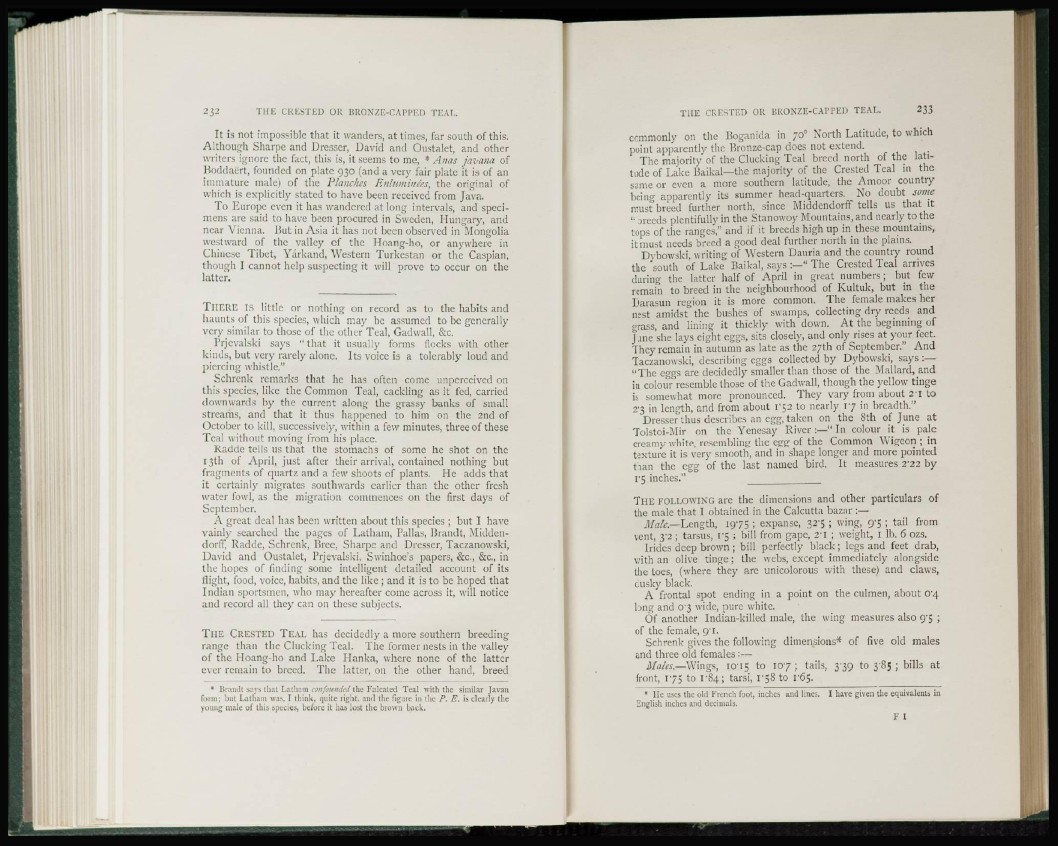
It is not impossible that it wanders, at times, far south of this.
Although Sharpe and Dresser, David and Oustalct, and other
writers ignore the fact, this is, it seems to me, * Anas javana of
Boddaert, founded on plate 930 (and a very fair plate it is of an
immature male) of the Planches Enlumintles, the original of
which is explicitly stated to have been received from Java.
To Europe even it has wandered at long intervals, and specimens
are said to have been procured in Sweden, Hungary, and
near Vienna. But in Asia it has not been observed in Mongolia
westward of the valley of the Hoang-ho, or anywhere in
Chinese Tibet, Yarkand, Western Turkestan or the Caspian,
though I cannot help suspecting it will prove to occur on the
latter.
THERE IS little or nothing on record as to the habits and
haunts of this species, which may be assumed to be generally
very similar to those of the other Teal, Gadwall, &c.
Prjevalski says " that it usually forms flocks with other
kinds, but very rarely alone. Its voice is a tolerably loud and
piercing whistle."
Schrenk remarks that he has often come unperceived on
this species, like the Common Teal, cackling as it fed, carried
downwards by the current along- the grassy banks of small
streams, and that it thus happened to him on the 2nd of
October to kill, successively, within a few minutes, three of these
Teal without moving from his place.
Radde tells us that the stomachs of some he shot on the
13th of April, just after their arrival, contained nothing but
fragments of quartz and a few shoots of plants. He adds that
it certainly migrates southwards earlier than the other fresh
water fowl, as the migration commences on the first days of
September.
A great deal has been written about this species ; but I have
vainly searched the pages of Latham, Pallas, Brandt, Middendorff,
Radde, Schrenk, Bree, Sharpe and Dresser, Taczanowski,
David and Oustalet, Prjevalski, Swinhoe's papers, &c, &c, in
the hopes of finding some intelligent detailed account of its
flight, food, voice, habits, and the like ; and it is to be hoped that
Indian sportsmen, who may hereafter come across it, will notice
and record all they can on these subjects.
THE CRESTED TEAL has decidedly a more southern breeding
range than the Clucking Teal. The former nests in the valley
of the Hoang-ho and Lake Hanka, where none of the latter
ever remain to breed. The latter, on the other hand, breed
* Brandt says that Latham confounded ihe Falcated Teal with the similar Javan
form; but Latham was, I think, quite light, and the figure in the P. E, is clearly the
young male of this species, before it has lost the brown back.
commonly on the Boganida in 70° North Latitude, to which
point apparently the Bronze-cap does not extend.
The majority of the Clucking Teal breed north of the latitude
of Lake Baikal—the majority of the Crested Teal in the
same or even a more southern latitude, the Amoor country
being apparently its summer head-quarters. No doubt some
must breed further north, since Middendorff tells us that it
" breeds plentifully in the Stanowoy Mountains, and nearly to the
tops of the ranges," and if it breeds high up in these mountains,
it must needs breed a good deal further north in the plains.
Dybowski, writing of Western Dauria and the country round
the south of Lake Baikal, says :—" The Crested Teal arrives
during the latter half of April in great numbers; but few
remain to breed in the neighbourhood of Kultuk, but in the
Darasun region it is more common. The female makes her
nest amidst the bushes of swamps, collecting dry reeds and
grass, and lining it thickly with down. At the beginning of
June she lays eight eggs, sits closely, and only rises at your feet.
They remain in autumn as late as the 27th of September." And
Taczanowski, describing eggs collected by Dybowski, says :—•
" The eggs arc decidedly smaller than those of the Mallard, and
in colour resemble those of the Gadwall, though the yellow tinge
is somewhat more pronounced. They vary from about 2- i to
2'3 in length, and from about 1*52 to nearly 1-7 in breadth."
Dresser thus describes an egg, taken on the 8th of June at
Tolstoi-Mir on the Yenesay River:—" In colour it is pale
creamy white, resembling the egg of the Common Wigeon ; in
texture it is very smooth, and in shape longer and more pointed
than the egg of the last named bird. It measures 2-22 by
1*5 inches."
THE FOLLOWING are the dimensions and other particulars of
the male that I obtained in the Calcutta bazur :—
Male.—Length, 19-75 ; expanse, 32-5 ; wing, 9-5 ; tail from
vent, 3-2 ; tarsus, i'5 ; bill from gape, 2-1 ; weight, I lib. 6 ozs.
Irides deep brown; bill perfectly black; legs and feet drab,
with an olive tinge; the webs, except immediately alongside
the toes, (where they are unicolorous with these) and claws,
dusky black.
A frontal spot ending in a point on the culmen, about 0'4
long and 03 wide, pure white.
Of another Indian-killed male, the wing measures also 9-5 ;
of the female, g'l.
Schrenk gives the following dimensions* of five old males
and three old females :—
Males.—Wings, 1015 to 10-7; tails, 3-39 to 3-85 ; bills at
front, 1-75 to 1-84; tarsi, 1-58 to 165.
' He uses the old French foot, inches and lines. I have given the equivalents in
English inches and decimals.
F I